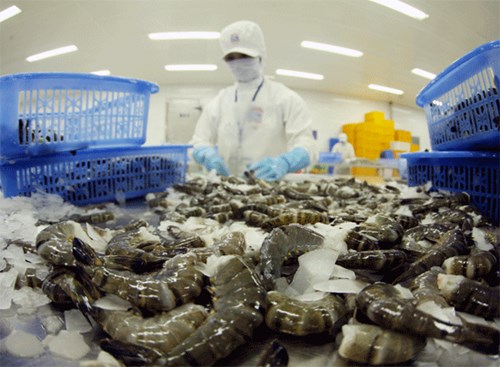The growth was fairly even in three main sectors with agro-forestry-fishery increasing by 4.05 percent, industry-construction posting a 9.7 percent growth rate and services climbing 6.7 percent.
Meanwhile, the processing and manufacturing sector witnessed a record growth of 13.56 percent in recent seven years.
    |
 |
|
Export revenue estimated at USD 54.31 billion, up 22 percent. Photo for illustration: doanhnghiepvn.vn |
The economic restructuring is moving in a rational fashion with the agro-forestry-fishery sector accounting for a proportion of 10.34 percent in the economy while the industry-construction and services sectors making up of 35.26 percent and 43.77 percent, respectively.
More than 26,700 enterprises were established during January-March, with total registered capital of nearly VND 278.5 trillion (USD 12.25 billion), up 1.2 percent in volume and 2.7 percent in value compared to the same time last year.
Nearly 7,900 businesses added VND 485.5 trillion to their capital while 8,449 others resumed operations.
The economy boasted strong development prospects as the number of enterprises that ceased operations dropped 1.4 percent to 8,115 while many enterprises felt upbeat about their stable production and business situations, according to a survey from the General Statistics Office of Vietnam.
Also, domestic production was stimulated by a surge of 9.9 percent in retail sales and revenue of consumption services to more than VND 1 trillion (USD 44 million).
There was also a boom in the number of international arrivals to Vietnam, with over 4.2 million people, up 30.9 percent year-on-year.
In the period, non-state investment totaled VND 138.8 trillion (USD 6.1 billion), or 41.9 percent of the total investment, much higher than foreign direct investment which made up 26.5 percent.
Export revenue was estimated at USD 54.31 billion, up 22 percent. Thriving growth was seen in key export markets like China (46 percent), the Republic of Korea (35.8 percent), the EU (19.7 percent), ASEAN (13.5 percent), Japan (12 percent) and the US (11.3 percent).
Although the increase in some public services and gasoline prices, wages and credit scale exert a lot of pressure on the consumer price index (CPI), the rate was under control. The Quarter 1’s CPI grew 2.82 percent while core inflation (CPI exclusive of fresh food, energy and State-run health and education services) was up 1.34 percent.
The robust achievements were spurred by sound economic growth in Quarter 4 of 2017, new opportunities from stable economic development and efforts of the business community and drastic state management.
This year, Vietnam has many advantages to realize its GDP growth target of 6.7 percent like improved business climate and increased exports of agricultural products, garments and textiles, footwear, telephones, spare parts and electronic products.
However, inflation rate, public debt, technical barriers and difficulties in responding to climate change are in the first line of the country’s challenges this year. Relevant ministries and sectors must follow the scenario of the CPI growth rate of 3.55 percent to take specific measures and solutions while putting forth state capital divestment at large corporations and enhancing financial disciplines and tax inspections.
Source: VNA